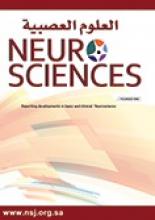Research ArticleOriginal Article
Open Access
The cranial capacity of the Saudi population measured using 3D computed tomography scans
Khalaf A. Alshamrani
Neurosciences Journal July 2023, 28 (3) 184-189; DOI: https://doi.org/10.17712/nsj.2023.3.20230005
Khalaf A. Alshamrani
From the Department of Radiological sciences, Faculty of Applied Medical Science, and from Health Research Centre, Najran University, Najran, Kingdom of Saudi Arabia
MSc, PhD.
References
- 1.↵
- 2.↵
- Ma D,
- Popuri K,
- Bhalla M,
- Sangha O,
- Lu D,
- Cao J, et al.
- 3.↵
- VanSickle C,
- Cofran Z,
- Hunt D.
- 4.↵
- Sulong S,
- Alias A,
- Johanabas F,
- Yap Abdullah J,
- Idris B.
- 5.↵
- Murthy SB.
- 6.↵
- Taher MB,
- Pearson J,
- Cohen MT,
- Offiah AC.
- 7.↵
- Bertsatos A,
- Chovalopoulou ME,
- Brůžek J,
- Bejdová Š.
- 8.↵
- Neves CA,
- Tran ED,
- Kessler IM,
- Blevins NH.
- 9.↵
- Wang Y,
- Wang H,
- Shen K,
- Chang J,
- Cui J.
- 10.↵
- Cacciaguerra G,
- Palermo M,
- Marino L,
- Rapisarda FAS,
- Pavone P,
- Falsaperla R, et al.
- 11.↵
- Qian Y,
- Zhang S,
- Tan Q,
- Xia J,
- Jin G.
- 12.↵
- Ni X,
- Ji Q,
- Wu W,
- Shao Q,
- Ji Y,
- Zhang C, et al.
- 13.
- Ghosh S,
- Kasher M,
- Malkina I,
- Livshits G.
- 14.↵
- Nowzari H,
- Jorgensen M.
- 15.↵
- Simmons-Ehrhardt TL,
- Ehrhardt CJ,
- Monson KL.
- 16.↵
- Khanduri S,
- Malik S,
- Khan N,
- Patel YD,
- Khan A,
- Chawla H, et al.
- 17.↵3D Slicer image computing platform | 3D Slicer [Internet]. [cited 2023 Jan 10]. Available from: https://www.slicer.org/
- 18.↵
- Scianò F,
- Zedda N,
- Mongillo J,
- Gualdi-Russo E,
- Bramanti B.
- 19.↵
- de Jong LW,
- Vidal JS,
- Forsberg LE,
- Zijdenbos AP,
- Haight T,
- Sigurdsson S, et al.
- 20.↵
- Eboh DE,
- Okoro EC,
- Iteire KA.
- 21.↵
- Aladeyelu OS,
- Olaniyi KS,
- Olojede SO,
- Mbatha WBE,
- Sibiya AL,
- Rennie CO.
- 22.↵
- Márcia Viana Wanzeler A,
- Melo Alves-Júnior S,
- Ayres L,
- Carolina da Costa Prestes M,
- Teixeira Gomes J,
- Mesquita Tuji F.
- 23.↵
- Beals KL,
- Smith CL,
- Dodd SM,
- Angel JL,
- Armstrong E,
- Blumenberg B, et al.
- 24.↵
- Rushton JP.
- 25.↵
- Ilayperuma I.
- 26.↵
- Kim YS,
- Park IS,
- Kim HJ,
- Kim D,
- Lee NJ,
- Rhyu IJ.
- 27.↵
- McCormick WF,
- Acosta-Rua GJ.
- 28.↵
- Lorenzo C,
- Carretero JM,
- Arsuaga JL,
- Gracia A,
- Marti´nez I,
- Marti´nez M
- 29.↵
- 30.↵
- Bin Sunaid FF,
- Al-Jawaldeh A,
- Almutairi MW,
- Alobaid RA,
- Alfuraih TM,
- Bin Saidan FN, et al.
In this issue
The cranial capacity of the Saudi population measured using 3D computed tomography scans
Khalaf A. Alshamrani
Neurosciences Journal Jul 2023, 28 (3) 184-189; DOI: 10.17712/nsj.2023.3.20230005
Jump to section
Related Articles
- No related articles found.
Cited By...
- No citing articles found.





